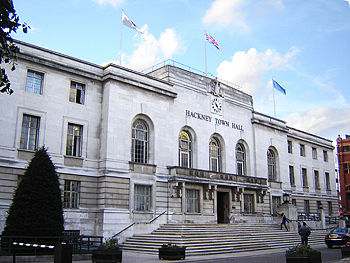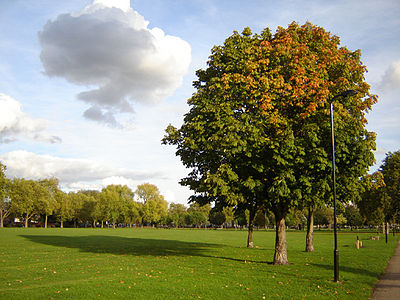- Politics of Hackney
-
 Hackney Town Hall was built in the 1930s for the old Metropolitan Borough. (October 2005)
Hackney Town Hall was built in the 1930s for the old Metropolitan Borough. (October 2005)
The London Borough of Hackney is a Labour Party governed inner London borough. The fifty-seven seats representing the nineteen wards of the Borough are divided between the Labour Party with fifty; the Conservative Party with four, and Liberal Democrats three.[1]
The Borough consists of two parliamentary constituencies: Hackney North and Stoke Newington (represented by Diane Abbott) and Hackney South and Shoreditch (represented by Meg Hillier; both Labour Party Members of Parliament). The Borough is a constituent part of the North East London Assembly seat with the London Borough of Islington and London Borough of Waltham Forest currently held by Jennette Arnold AM. The Borough also makes up a constituent part of the London constituency of the European Parliament.
Contents
Current structure
Unlike most other English local authorities, the Borough is now governed by a directly-elected Mayor who is also the political leader of the council. The Mayor elected for a second term in office and representing the Labour Party, is Jules Pipe CBE and is supported by a Cabinet, Councillors and a Speaker, currently for 2010-2011 Councillor Sally Mulready; who fulfils the civic and ceremonial duties previously undertaken by the (non-political) mayor[2].
The Borough is divided in to nineteen electoral wards, each returning three Councillors in a first three past the post system of elections. The Mayor of Hackney selects approximately nine Councillors to make up a Cabinet[3] whom take responsibility of the governance of the Borough's civil service, and represent the Mayor and Council on strategic bodies such as Team Hackney[4], the Arms Length Management Organisation (ALMO) Hackney Homes[5] which governs the Borough's estate, and the Learning Trust[6], governing the provision of education within the Borough.
The quasi-judicial functions of the Council called Regulatory, are carried out by exclusively back-bench Councillors. The Planning Sub-Committee[7] and the Licensing Committee[8] make independent decisions that oversee both the private and public sector and decide upon a wide range of petitions for permission to build, demolish or otherwise transform the built environment and upon requests for license for the public display of wild animals thru public entertainment to the transport of hazardous waste. The other committees that make up Regulatory are the Standards Committee, Regulatory Committee, Pensions Sub-Committee, and Audit Sub-Committee.
The Mayor, Cabinet, and Regulatory are all held to account by the system of Overview and Scrutiny (O&S). This is formed into an Overview and Scrutiny Board, chaired normally by the leader of the opposition but currently by a Councillor nominated by the Conservative Party group, and the Scrutiny Commissions, the five sub-committees of the Board[9].
- Children and Young People Scrutiny Commission
- Community Safety and Social Inclusion Scrutiny Commission
- Governance and Resources Scrutiny Commission
- Health in Hackney Scrutiny Commission
- Living in Hackney Scrutiny Commission
2010 elections
Main article: Hackney Council election, 2010At the Hackney Council election on 6 May 2010 the Labour Party were returned with 50 councillors; winning six additional seats. The Conservative Party forms the largest opposition party on the council with four councillors; and the Liberal Democrats have three.[10]
2006 elections
Main article: Hackney Council election, 2006On the 4 May 2006 Hackney Council local elections the Labour Party were returned with forty-four Councillors, winning one seat and losing one. The Conservative Party formed the largest opposition party in the Council with nine Councillors, the Liberal Democrats won three seats, and for only the second time a candidate from the Green Party was elected[11].
The Labour party majority increased in 2008, following the defection of the Liberal Democrat representative of Cazenove ward Councillor Joseph Stauber to thirty-three.[12]
History
The borough was formed in 1965 from the area of the former metropolitan boroughs of Hackney, Shoreditch and Stoke Newington.
For most of that time it has been a Labour run authority, although there was a period of Conservative administration from 1968 to 1972
There was a period of changing coalitions during the 1990s. These coalitions followed the upheaval following the Mark Trotter affair,[13] involving allegations of a cover up over a child abuse scandal[14] when the Labour Party split between Councillors following the former mayor Nick Tallentire (which called themselves "The Hackney New Labour Group"[15]) and councillors following the former council leader John McCafferty, who eventually got the backing of the national Labour party.[16] There was a brief period when John McCafferty led a minority administration followed by a loose coalition of Hackney New Labour, the Liberal Democrats and the Conservatives. By the 1998 election all but two of the Hackney New Labour councillors defected to either the Liberal Democrats or the Conservatives and a coalition was launched after the council between the Liberal Democrats, the Conservatives and two Green Party councillors. After this there was a coalition between Labour led by Jules Pipe and the Conservatives led by Eric Ollerenshaw. After the 2002 borough elections the Labour returned as the majority party.
Borough Wards
The nineteen wards in that make up the Borough are mostly made up of four polling districts, the exception being Dalston ward with five. Most are named after geographical locations or features with the exceptions of Chatham and Stoke Newington Central centred on Stoke Newington High Street, part of the Roman Ermine Street, the Central part both separating the surrounding parts of Stoke Newington that are parts of neighbouring wards and also apeing Hackney Central. The only ward named after street is Clissold for Clissold Crescent and not Clissold Park located in neighbouring Lordship ward. Most are named for the hamlets originally found there, Haggerston, Hoxton, and Wick, country estates between the hamlets, Brownswood after Brownswood Park and Lordship after Lordship Park, or the planned developments themselves, Cazenove, De Beauvoir, and Kings Park. Three are named after parks, Hackney Downs, Springfield Park, Hackney, and Victoria Park, East London although after a boundary change there no longer is any part of Victoria Park within the Borough. Two are named after bridges the first of the River Lea and the other Queensbridge after a bridge over the Regents Canal. Finally two are named after the two railway stations Hackney Central railway station and Dalston Junction.
- Brownswood
- Cazenove
- Chatham
- Clissold
- Dalston
- De Beauvoir
- Hackney Central
- Hackney Downs
- Haggerston
- Hoxton
- Kings Park
- Leabridge Park
- Lordship
- New River
- Queensbridge
- Springfield
- Stoke Newington Central
- Victoria
- Wick
External links
- Official Hackney Council Website
- Registering for the electoral register in Hackney
- www.hackney-labour.org.uk
- www.hackneyconservatives.com
- www.hackneylibdems.org.uk
- www.hackney.greenparty.org.uk
- www.hackneyindependent.org
References
- ^ Mayor and Council Elections 2010 accessed 26 May 2010
- ^ The Speaker of Hackney Council accessed 27 May 2010
- ^ Hackney Borough Cabinet 2008-09 accessed 5 June 2008
- ^ Team Hackney accessed 5 June 2008
- ^ Hackney Homes accessed 5 June 2008
- ^ The Learning Trust accessed 5 June 2008
- ^ Planning Committee accessed 5 June 2008
- ^ Licensing Committee accessed 5 June 2008
- ^ O&S accessed 5 June 2008
- ^ Mayor and Council Elections 2010 accessed 26 May 2010
- ^ Mayor and Council Elections 2006 accessed 10 May 2007
- ^ LibDem joins Labour, saying ‘Ken is our friend’ Jewish Chronicle, 8 February 2008
- ^ Children at risk: Council condemned in child abuse inquiry, The Independent, London, 8 Jan, 1998, by Glenda Cooper
- ^ Press Complaints commission
- ^ Hackney council splits over inquiry, The Independent, London, Sep 13, 1996 by John Rentoul
- ^ Council criticised over paedophile scandal, BBC, Wednesday, January 7, 1998
Categories:
Wikimedia Foundation. 2010.

